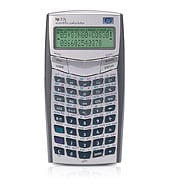Hp 32s Rpn Scientific Manual
I was an undergraduate in Engineering school in the mid-'70s when HP began to first introduce their RPN scientific calculators, beginning with the HP-35 model. Each subsequent model was received with much fanfare, and it's amazing to realize how basic and expensive those first models were compared to what is available today. But that's how it goes with technology, and after all we're talking about four decades of advancement since those first models were introduced. I have both the and calculators, and they have been my every day workhorses for office and home use since I first purchased them. My HP 32S shows a date of 1987 on the serial number plate on the back of the calculator, as well as a 'Made in USA'. Driver Hp Laserjet P10006 Download on this page. It may have been one of the last models to have been made here before all calculator production moved overseas.
My HP 32Sii calculator also shows a date of 1987 and was made in Indonesia. I'm guessing that I purchased it a few years after getting the 32S, thinking that I would have it as a spare when the 32S finally stopped working, which is something that never came about. Both of these calculators have worked perfectly for the close to three decades I've had them, with basically daily use. I replace the batteries every few years. That's phenomenal reliability and durability, as far as I'm concerned.
Get Textbooks on Google Play. Rent and save from the world's largest eBookstore. Read, highlight, and take notes, across web, tablet, and phone. Windows Xp Pro Sp3 Hp Oem Downloads more. Technical Details - Calling all engineers--Hewlett-Packard's HP32SII Scientific Calculator is the calculator for you. With 384 bytes of memory, 26 variable keys, more than 100 built-in scientific and mathematical functions, and RPN data entry, you'll find everything you need for efficient and fast calculating in this compact unit.
With respect to the capabilities of these calculators, they satisfy all of the basic engineering and scientific needs, and the 32Sii model has considerably more capabilities with built-in conversions and various math and scientific functions. These days, I doubt that many people will purchase or use one of these calculators for any very sophisticated calculations, although they are still quite usable in that way. I personally use mine for basic desktop calculations. It's interesting to see them still available here on Amazon, even a few 'new' ones apparently still available, likely of interest mainly to collectors and to those who still prefer this style of calculator. And in fact the RPN style of calculator probably appeals only to small a niche group of people these days, but for someone who 'grew up' with RPN it is comfortable to use and I still prefer it to the more common calculators with the '=' sign (aka 'algebraic data entry'; if you understand RPN then you know what I'm talking about). Even so, I think that HP finally acceded to the popularity of non-RPN calculators and began to release models that had both capabilities, such as their current.

These 32S and 32Sii calculators will continue to be my desktop companions for as long as I continue to require a calculator for my home and office needs. Long live RPN!!
HP-32S The Museum of HP Calculators HP-32S The HP-32S was an inexpensive yet powerful calculator. It had a single line display but with many annunciators to convey additional information. It had a fairly uncluttered keyboard due to its menu system yet it was packed with such features as: • Basic scientific functions including hyperbolic functions. • Statistics.
• Probability. • Solver (Solved functions.) • Numeric integration (of RPN functions.) • Binary, octal, decimal and hexadecimal bases. (With windowing to view long binary numbers.) • Complex Arithmetic functions (see below.) • 390 Bytes of user memory. • Variables instead of numbered registers (see below.) • Programmability (see below.) • Obvious error messages (like Divide By 0.) Complex arithmetic Instead of the 's complex mode, the HP-32S had just one mode but allowed the CMPLX key to be used as a prefix to the other functions in much the same way other calculators used HYP or ARC prefixes on trigonometric functions.
The Functions that could be prefixed with CMPLX were: • +/- (change sign) • 1/x • LN and e^x • SIN, COS, TAN • +, -, *, / Because there was no complex 'mode' and no 'complex stack' as on the, complex numbers were each entered into two levels of the normal stack. Variables Instead Of Numbered Registers The calculator used the 27 lettered variables A-Z and i (indirection) rather than numbered variables. While these variables were used in much the same way as numeric registers, they were more than just a relabeling. The lettered variables were not allocated from memory until used and they could be individually deallocated by simply storing 0 in them. When RCL or STO was pressed, an A.Z annunciator appeared.
The letters A-Z where printed to the sides of the keys. All the variables could be scanned with the VAR command. A single variable could be displayed without entering it on the stack by pressing VIEW followed by the letter.